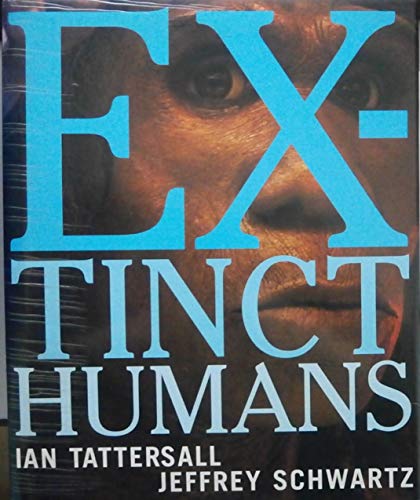Verwandte Artikel zu Extinct Humans

Zu dieser ISBN ist aktuell kein Angebot verfügbar.
Alle Exemplare der Ausgabe mit dieser ISBN anzeigen:Book by Tattersall Ian Schwartz Jeffrey
Die Inhaltsangabe kann sich auf eine andere Ausgabe dieses Titels beziehen.
Reseña del editor:
An assessment of human evolution that theorizes that many more species of humans than previously thought have existed during the six million year history of the hominid family.. Scientists have long envisioned the human family tree as a straight-line progression from the apelike australopithecines to the enigmatic Homo habilis to the famous Neanderthals, culminating in us, Homo sapiens . But this model is unlike the evolutionary patterns known for all other vertebratespatterns that typically reveal multiple branchings and extinctions. In Extinct Humans , Ian Tattersall and Jeffrey Schwartz present convincing evidence that many distinct species of humans have existed during the history of the hominid family, often simultaneously. Furthermore, these species may have contributed to one another's extinction. Who were these different human species? Which are direct ancestors to us? And, the most profound question of all, why is there only a single human species alive on Earth now? Tattersall and Schwartz explore these questions and many more. }From the earliest days of their science, paleoanthropologists have shown a propensity to envision the human family tree as a straight-line progression from the apelike australopithecines to the enigmatic Homo habilis to the perhaps misapprehended Homo erectus to the famous (or infamous) Neanderthals, culminating in us, Homo sapiens . The problem is that this model is unlike the evolutionary pattern of any other known vertebrate (or any organism, for that matter) which reveals multiple branching and extinctions.Since mid-century it has been evident that in South Africa two species of australopithecines existed at the same time, one of which a specialized vegetarian went extinct, leaving no successors. Then fossils were unearthed that demonstrated early members of our genus ( Homo ) existed side by side with australopithecines, complicating the picture still further. Now it is becoming increasingly clear that the Neanderthals were not a direct ancestor to modern humans but were in fact a side branch whose extirpation was at least partially at the hands of our modern human ancestors who invaded Europe 40,000 years ago. And very recent re-dating of several Javanese Homo erectus fossils has cast doubt on the notion that this widespread population was our direct ancestor.In Extinct Humans , Ian Tattersall and Jeffrey Schwartz present convincing evidence that over fifteen different species of humans have existed over the six million-year sojourn of the hominid family, and that many of these species have existed simultaneously. Furthermore, a large number of these were members of our own genus. Who were these different human species? What did they look like? When and where did they evolve? Which are direct ancestors to us and which went extinct, leaving no successors? And, the most profound question of all, why is there only a single human species alive on Earth now? Tattersall and Schwartz explore these questions and many more in Extinct Humans . } Early on anthropologists envisioned the human "family tree" as a straight line progression from the bipedal apes to Homo habilis to Homo erectus to the Neanderthals culminating in us, Homo sapiens. The problem was that this model was unlike the evolutionary pattern of any other known vertebrate (or any organism for that matter) which revealed multiple branching and extinctions. It wasn't long before a number of South African fossils were discovered that demonstrated two species of these early bipedal apes existed at the same time, one of which was a specialized vegetarian that went extinct, leaving no successors. Then it became increasingly apparent that the Neanderthals were not a direct ancestor to modern humans but were in fact a side branch whose extirpation was at least partially at the hands of our direct modern human ancestors who invaded Europe 40,000 years ago.Extinct Humans presents convincing evidence that over 15 different species of humans have existed over time, and that during the period of 3 to 1 million years ago upwards of 10 different species of humans existed simultaneously. How did they differ from us? What did they look like? Which are direct ancestors to us and which went extinct leaving no successors? And probably most curious of all, why now is there only a single human species?
Biografía del autor:
Ian Tattersall is Chairman and Curator of the Department of Anthropology at the American Museum of Natural History and adjunct professor of anthropology at Columbia University. His books include The Fossil Train, The Human Odyssey, Becoming Human, and The Myths of Human Evolution (with Niles Eldredge). Jeffrey Schwartz is professor of physical anthropology at the University of Pittsburgh and a research associate at the American Museum of Natural History. He is the author of The Red Ape, What Bones Tell Us, and Skeleton Keys.
„Über diesen Titel“ kann sich auf eine andere Ausgabe dieses Titels beziehen.
- VerlagWestview Press Inc
- Erscheinungsdatum2000
- ISBN 10 0813334829
- ISBN 13 9780813334820
- EinbandTapa dura
- Anzahl der Seiten224
- Bewertung
(Keine Angebote verfügbar)
Buch Finden: Kaufgesuch aufgebenSie kennen Autor und Titel des Buches und finden es trotzdem nicht auf ZVAB? Dann geben Sie einen Suchauftrag auf und wir informieren Sie automatisch, sobald das Buch verfügbar ist!
Kaufgesuch aufgeben
